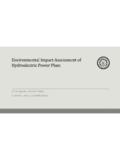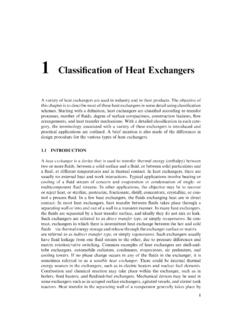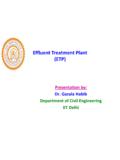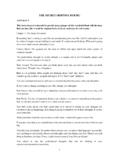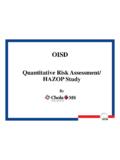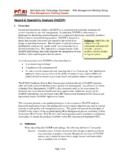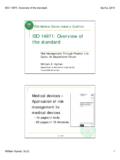Transcription of Industrial Risk Management Overview - Indian …
1 Overview OF. Industrial RISK. assessment . Requirements in the Directive Top Tier Sites - Article 9(b) - demonstrating that major- accident hazards have been identified and that the necessary measures have been taken to prevent such accidents and to limit their consequences for man and the environment;. Lower Tier Sites - ANNEX III(ii) - identification and evaluation of major hazards adoption and implementation of procedures for systematically identifying major hazards arising from normal and abnormal operation and the assessment of their likelihood and severity;. Definition of Hazard and Risk Hazard: the property of a substance or situation with the potential for creating damage Risk: the likelihood of a specific effect within a specified period complexfunction of probability, consequences and vulnerability Risk assessment Risk assessment and risk analysis of technical systems can be defined as a set of systematic methods to: Identify hazards Quantify risks Determine components, safety measures and/or human interventions important for plant safety Risk assessment Risk analysis is teamwork Ideally risk analysis should be done by bringing together experts with different backgrounds: chemicals human error process equipment Risk assessment is a continuous process!
2 Risk assessment System definition Hazard identification Scheme for qualitative and quantitative Analysis of accident scenarios assessments Estimation of accident frequencies At all steps, risk reducing measures Consequence analysis and modelling need to be considered Risk estimation Risk Analysis Main Steps Risk Analysis Hazard Identification What if . Checklists HAZOP. Hazard & Scenario Analysis Task analysis Index (Dow, Mond). Likelihood Consequences Risk Risk Analysis Main Steps Risk Analysis Hazard Identification Hazard & Scenario Analysis Fault tree analysis Event tree analysis Likelihood Consequences Bowties Barrier diagrams Reliability data Human reliability Risk Consequence models Risk Analysis Main Steps Risk Analysis Hazard Identification Hazard & Scenario Analysis Identify Safety Likelihood Consequences Barriers Risk Preliminary hazard identification Identification of safety relevant sections of the establishment, considering raw materials and products plant equipment and facility layout operation environment operational activities interfaces among system components Important to secure Completeness, Consistency and Correctness Methods for hazard identification What if.
3 Checklists HAZOP. Task analysis Index (Dow, Mond). Failure mode and effects analysis (FMEA). The HAZOP Method HAZOP analysis is a systematic technique for identifying hazards and operability problems throughout an entire facility. It is particularly useful to identify unwanted hazards designed into facilities due to lack of information, or introduced into existing facilities due to changes in process conditions or operating procedures. The objectives of a HAZOP study are to detect any predictable deviation (undesirable event) in a process or a system. This purpose is achieved by a systematic study of the operations in each process phase. The HAZOP Method The system is divided into functional blocks Every part of the process is examined for possible deviations from the design intention Can the deviations cause any hazard or inconvenience?
4 Every phase of the process Each system and person Questions formulated around guide words Each deviation is considered to decide how it could be caused and what the consequences would be For the hazards preventive/remedying actions are defined HAZOP Study Consequence 1. Definition of the objectives and scope of the study, hazards having only off-site impact or only on- site impact, areas of the plant to be considered, etc. 2. Assembly of a HAZOP study team. 3. Collection of the required documentation, drawings and process description. 4. Analysis of each major item of equipment, and all supporting equipment, piping and instrumentation 5. Documentation of the consequences of any deviation from normal and highlights of those which are considered hazardous and credible. HAZOP Study team HAZOP studies are normally carried out by multi-disciplinary teams.
5 There are two types of team members, namely those who will make a technical contribution and those play a supporting and structuring role. Example of HAZOP Matrix Guide word No Low High Part of Also Other than Reverse Process- variable No Low High Missing Wrong Reverse Flow flow flow flow ingredients Impurities material flow Low High Low High - - Level Empty interface interface level level Open to Low High - - - Pressure atmosphere pressure pressure Vacuum Temperature Low High - - - Auto Freezing temp. temp. refrigeration No Poor Excessive Irregular- Foaming - Phase Agitation mixing mixing agitation mixing separation No Slow "Runaway Partial Side Wrong Decom- Reaction reaction reaction reaction reaction" reaction reaction position Utility External External - - Start-up - Other Shutdown failure leak rupture Maintenance HAZOP Criticality analysis Criticality - combination of severity of an effect and the probability or expected frequency of occurrence.
6 The objective of a criticality analysis is to quantify the relative importance of each failure effect, so that priorities to reduce the probability or to mitigate the severity can be taken. Example formula for Criticality: Cr = P B S. Cr: criticality number P: probability of occurrence in an year B: conditional probability that the severest consequence will occur S: severity of the severest consequence HAZOP Criticality analysis The criticality number - used to rank the identified deviations in a HAZOP or FMEA. study - cannot be used as a risk measure - product of three rough estimates Before a criticality analysis can be performed guidelines have to be developed on how to determine P, B and S. There are no generally accepted criteria for criticality applicable to a system. Example values for P, B and S.
7 Categories Probability Cond. Probabil Severity P B S. Very rare 1 Very low 1 Low 1. Rare 2 Low 2 Significant 2. Likely 3 Significant 3 High 3. Frequent 4 high 4 Very high 4. Interpretation of the values Probability (P). very rare - less than once in 100 years rare - between once in 10 y. and once in 100 y. likely - between once a year and once in 10 years frequent - more frequent than once a year Conditional probability (B). very low - less than once every 1000 occurrences of the cause low - less than once every 100 occurrences of the cause significant - less than once every 10 occurrences of the cause high - more than once every 10 occurrences of the cause Severity (S). low - no or minor economical loss/small, transient environmental damage significant - considerable economic losses/considerable transient environmental damage/slight non-permanent injury high - major economic loss/considerable release of hazardous material/serious temporary injury very high - major release of hazardous material/permanent injury or fatality Decision making Criticality Judgement Meaning Cr < X Acceptable No action required X < Cr < Y Consider Should be mitigated within a modification reasonable time period unless costs demonstrably outweight benefits Cr > Y Not Should be mitigated as soon as acceptable possible The values X and Y have to be determined by a decision-maker.
8 It might be necessary to formulate some additional criteria, for instance: every deviation for which the severity is classified as very high severity shall be evaluated to investigate the possibilities of reducing the undesired consequences. Risk assessment Using Index-based Methods Indexes can be used for risk ranking Process units can be assigned a score or index based on Type of substance (flammable, explosive and/or toxic properties). Type of process (pressure, temperature, chemical reactions). Quantity Ranking of the hazards Focus attention on hazard analysis for the most hazardous units Examples of Substance indexes Substance Hazard Index (SHI): Proposed by the Organization of Resources Counsellors (ORC) to OSHA. Based on a ratio of the equilibrium vapour pressure(EVP) at 20 oC divided by the toxicity concentration.
9 Material Hazard Index (MHI): Used by the state of California to determine threshold quantities of acutely hazardous materials for which risk Management and prevention programs must be developed. Substance and process indexes Dow Fire and Explosion Index (F&EI): Evaluates fire and explosion hazards associated with discrete process units. Mond Fire and Explosion Index: Developed by ICI's Mond Division, an extension of the Dow F&EI. These indices focus on fire and explosion hazards, Butane has a Dow Material Index of 21, and Ammonia 4. Fault Tree Analysis Graphical representation of the logical structure displaying the relationship between an undesired potential event (top event). and all its probable causes top-down approach to failure analysis starting with a potential undesirable event - top event determining all the ways in which it can occur mitigation measures can be developed to minimize the probability of the undesired event Fault Tree can help to.
10 Quantifying probability of top event occurrence Evaluating proposed system architecture attributes Assessing design modifications and identify areas requiring attention Complying with qualitative and quantitative safety/reliability objectives Qualitatively illustrate failure condition classification of a top- level event Establishing maintenance tasks and intervals from safety/reliability assessments Fault tree construction A N D g a te T h e A N D -g a te is u s e d to s h o w th a t th e o u tp u t e v e n t o c c u rs o n ly if a ll th e in p u t e v e n ts o c c u r O R g a te T h e O R -g a te is u s e d to s h o w th a t th e o u tp u t e v e n t o c c u rs o n ly if o n e o r m o re o f th e in p u t e v e n ts o c c u r B a s ic e v e n t A b a s ic e v e n t re q u ire s n o fu rth e r d e v e lo p m e n t b e c a u s e th e a p p ro p ria te lim it o f re s o lu tio n h a s b e e n re a c h e d I n te r m e d ia te e v e n t A fa u lt tre e e v e n t o c c u rs b e c a u s e o f o n e o r m o re a n te c e d e n t c a u s e s a c tin g th ro u g h lo g ic g a te s h a v e o c c u rre d T ra n sfer A tria n g le in d ic a te s th a t th e tre e is d e v e lo p e d fu rth e r a t th e o c c u rre n c e o f th e c o rre s p o n d in g tra n s fe r s y m b o l U n d e v e lo p e d e v e n t A d ia m o n d is u s e d to d e fin e a n e v e n t w h ic h is n o t fu rth e r d e v e lo p e d e ith e r b e c a u s e it is o f in s u ffic ie n t c o n s e q u e n c e o r b e c a u s e in fo rm a tio n is u n a v a ila b le Fault tree development procedure
